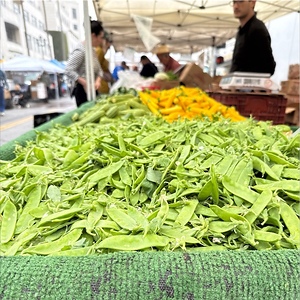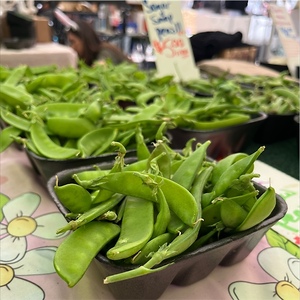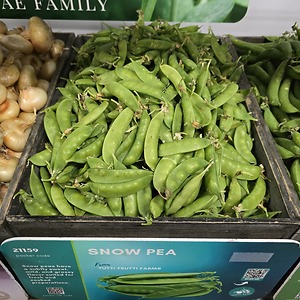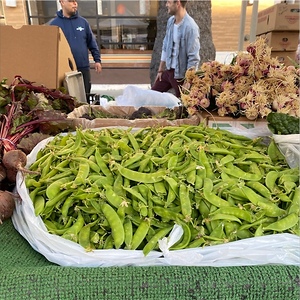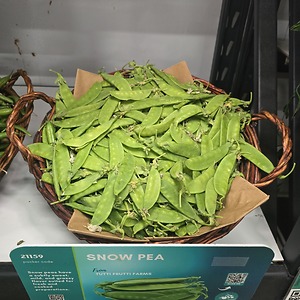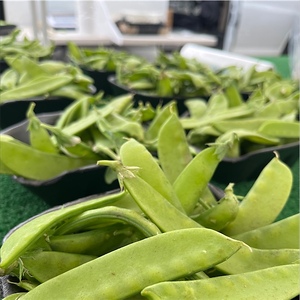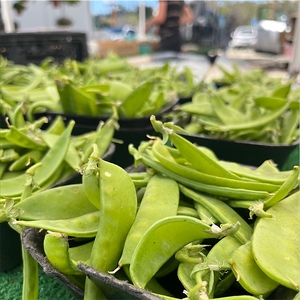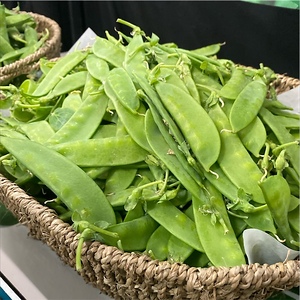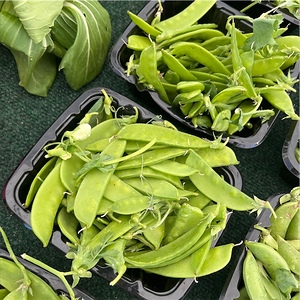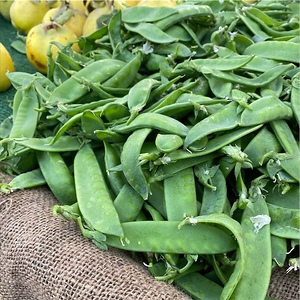

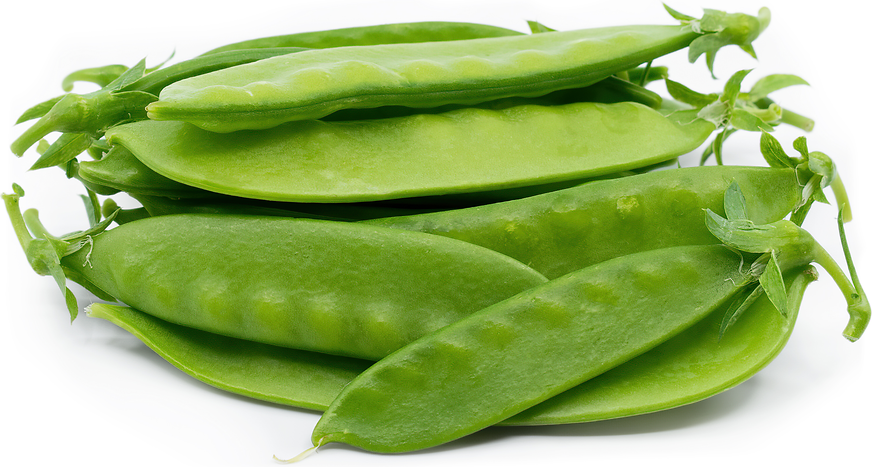
Snow Peas
Estimated Inventory, 10 lbs : 4.85
This item was last sold on : 07/14/25
Description/Taste
Snow peas are a small to medium-sized varietal, averaging 5 to 8 centimeters in length, and the pods have a flat, straight, oblong shape with tapered, pointed ends. There are remnants of the green calyx where the pods are attached to the stem, and the pods are smooth, pliable, and thin, showcasing the outline of the small peas forming inside. Each yellow-green to bright green pod may contain up to 7 peas, and the pale green peas are tiny, flattened, round, to oval in shape. Before consumption, there is a fibrous string that extends the length of the pod that should be peeled and discarded. Snow peas can be used fresh or cooked and have a tender, crisp, and slightly chewy consistency. Both the pods and peas are edible, as the pods contain less inedible fiber than other pea varieties, creating a softer mouthfeel. When selecting Snow peas, pick pods that are just starting to show small bulging seeds but ensure the peas have not become too large or bulbous. The pods will also have a small white string, and the string's coloring is a sign of freshness. Snow peas have a mild, subtly sweet taste with grassy, bright, and vegetal nuances.
Seasons/Availability
Snow peas are grown in greenhouses year-round and in commercial fields in the spring through early summer.
Current Facts
Snow peas, botanically classified as Pisum sativum, are an edible legume belonging to the Fabaceae family. The pods grow on herbaceous climbing vines extending over two meters in length and are typically harvested 8 to 10 days after pollination. Snow peas are picked before they reach maturity to ensure the pods remain crisp, tender, and succulent, and the peas stay small in size. Harvesting Snow peas early allows both the pod and the pea to be consumed in culinary preparations. Snow peas have been cultivated as a food source for centuries, and in the modern day, the peas are commercially produced worldwide. There are several regional names for Snow peas, including Kinusaya and Sayaendo in Japan, Ho Laan Dau translating to Holland pea or Dutch pea in China, Peultjes in Holland, Pois Mangetout in France, and Silk pods or Chinese peas. Snow peas received their frigid moniker from their ability to survive small amounts of frost and snow during cultivation. The plants are hardy and are one of the first vegetables to be planted in the spring, and the pods can be harvested throughout the season for a variety of fresh and cooked dishes.
Nutritional Value
Snow peas are a source of potassium to balance fluid levels within the body, iron to develop the protein hemoglobin for oxygen transport through the bloodstream, and fiber to regulate the digestive tract. The variety also provides vitamin C to strengthen the immune system while reducing inflammation, vitamin A to maintain healthy organ functioning, calcium to build strong bones and teeth, and other nutrients, including folic acid, vitamin K, magnesium, and B vitamins. In Traditional Chinese Medicine, peas are consumed to stimulate the digestive tract and cleanse the liver.
Applications
Snow peas have a subtly sweet, mild, and grassy flavor suited for fresh and cooked preparations. The calyx remnants and strings should be removed from the pods before consumption, and the pods cook quickly. Snow peas can be used raw in salads, or they can be served on crudité trays, eaten with herb dips, hummus, or cottage cheese. The pods can also be chopped and layered into spring rolls, sliced and mixed into grain bowls, or blanched, sliced into thin strips, and placed as a garnish or topping over main dishes. In addition to fresh preparations, Snow peas can be added to stir-fries, tossed into rice or noodle-based dishes, or incorporated into curries and soups. Snow peas can also be steamed into eggs, roasted with nuts, added to main meat dishes, or steamed and combined with fresh herbs, butter, and citrus as a zesty side dish. In Japan, Snow peas are traditionally simmered in a dashi broth, a side dish known as ohitashi. They are also mixed into chirashi sushi, meaning "scattered sushi," a rice-based bowl filled with ingredients commonly found in sushi. Beyond the edible pods and peas, young Snow pea greens, flowers, and shoots are edible and are popularly used as simple side dishes. Snow peas pair well with seafood such as shrimp, scallops, and white fish, nuts including cashews, peanuts, and almonds, citrus, aromatics such as garlic, ginger, shallots, and onions, spring vegetables such as mushrooms, radishes, and asparagus, and herbs including scallions, mint, parsley, and tarragon. Whole, unwashed Snow peas will keep for 3 to 7 days when stored in a plastic bag in the refrigerator. Once cooked, the pods should be eaten within 2 to 3 days. The pods can also be parboiled and frozen for extended use.
Ethnic/Cultural Info
Snow peas are known as Kinusaya in Japanese, a word used to describe the pod's similarity in appearance and sound to silk. It is said the glossy nature of the pods resembles the sheen of spun silk, and the sound of the pods rubbing together in dishes is thought to sound like the rubbing of silk fabric, especially silk kimonos. In Japan, Snow peas are celebrated on March 8th, a celebratory day created by the Federation of Agricultural Cooperatives in the Wakayama Prefecture. March 8th is known as Sayaendo Day, a word pun used to promote Saya peas, another name for Snow peas. The month of March is the peak season for the peas within the Wakayama Prefecture, and Sayaendo Day is promoted to celebrate the blessings that the harvest may bring. During the day, Snow peas are heavily marketed with large displays through local growers, and many Wakayama residents purchase fresh peas to use in meals honoring the season.
Geography/History
Snow peas have been cultivated since ancient times, and much of the history of the peas is unknown. Experts point to the Mediterranean, the Middle East, or Central Asia as possible origination sites. Snow peas were spread throughout Europe and Asia through trade routes, and they were thought to be introduced to China and Japan as early as the 7th and 8th centuries. It was in the Edo period in Japan, spanning from 1603 to 1868, that Snow peas were extensively cultivated and consumed as a staple culinary ingredient. Snow peas were also introduced to the New World via migrating peoples, and the peas became a widely planted garden crop. Today Snow peas are cultivated mainly in Japan in the Wakayama Prefecture, in the United States, especially in California, and in India, China, England, and Hungary. Outside of commercial production, the peas are grown in home gardens worldwide. Snow peas are sold domestically in local markets, grocers, and through distributors or are exported to neighboring countries.
Featured Restaurants
Restaurants currently purchasing this product as an ingredient for their menu.
| Plant Based Meals | San Diego CA | 858-255-0590 |
| Tribute Pizza | San Diego CA | 858-220-0030 |
| Parkhouse Eatery | San Diego CA | 619 295 7275 |
| Webbcreationfood LLC | San Diego CA | 619-829-9194 |
| Cloak and Petal | San Diego CA | 626-319-6878 |
| Green Acres Campus | San Diego CA | 858-450-9907 |
| Seasoned Catering and Events | San Diego CA | 619-246-4909 |
| Shoreside Support Boat | San Diego CA | 704-277-7929 |
| Pamplemousse Grill | Solana Beach CA | 858-792-9090 |
| The Farm Golf Club | Rancho Santa Fe CA | 858-756-5585 |
| Rosewood Social | San Juan Capistrano CA | 669-243-8403 |
| La Jolla Country Club | San Diego CA | 858-454-9601 |
| Gravity Heights Mission Valley | San Diego CA | 619-384-5993 |
| LANA | Solana Beach CA | 602-758-2596 |
| C 2 C | San Diego CA | 619-972-9345 |
| Harvest Kitchen | Vista CA | 619-709-0938 |
| Hotel La Jolla - Sea & Sky | La Jolla CA | 858-459-0261 |
| Brigantine La Mesa | La Mesa CA | 619-465-1935 |
| Solterra Winery + Kitchen | Encinitas CA | 858-245-6146 |
| Ridgeview Health Center | San Diego CA | 858-293-3950 |
| Reata Glen | Ladera Ranch CA | 949-545-2250 |
| Pacific Yacht Agents | Los Angeles CA | 808-214-0970 |
| Juniper & Ivy | San Diego CA | 858-481-3666 |
| Giaola | Carlsbad CA | 858-266-9303 |
| Town & Country Main Storeroom | San Diego CA | 619-291-7131 |
| InterContinental Banquet Kitchen | San Diego CA | 619-501-9400 |
| UCSD Food & Nutrition Department Hillcrest | San Diego CA | 619-380-9840 |
| Zeca Trading Co. | San Diego CA | 619-410-1576 |
| UCSD Food & Nutrition Department La Jolla | San Diego CA | 858-761-1269 |
| Roppongi (IB) | Imperial Beach CA | 858-456-8018 |
| Make Stuff Good | San Diego CA | 949-547-9470 |
Recipe Ideas
Recipes that include Snow Peas. One



